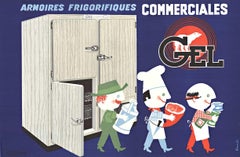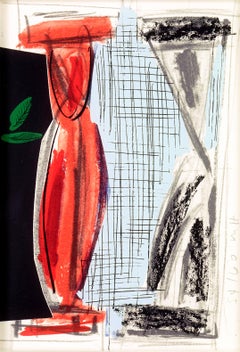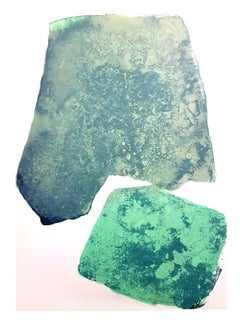Omnes Art
to
1
1
Overall Width
to
Overall Height
to
1
1
1
1
1
10,138
2,779
1,375
1,368
1
Artist: Omnes
GEL Armoires Frigorifiques Commerciales horizontal mid century vintage poster
By Omnes
Located in Spokane, WA
Delightful 1950s French Refrigerator Poster — “Armoires Frigorifiques Commerciales GEL” — Linen Backed, Original! Grade A, Å- condition. Very fine!
Searching for the coolest piec...
Category
1950s Conceptual Omnes Art
Materials
Lithograph
Related Items
Two Columns (framed): colorful pop art abstracted Greek pillars Micheal Hurson
By Michael Hurson
Located in New York, NY
Pop art scene of abstracted Greek pillars and green leaves. Drawings in black and white, pale blue, red and grey compose this colorful print. Layers of p...
Category
1980s Contemporary Omnes Art
Materials
Lithograph, Screen
$1,100
H 9.75 in W 7.5 in D 0.75 in
Pierre Tal Coat - Original Lithograph
By Pierre Tal-Coat
Located in Collonge Bellerive, Geneve, CH
Pierre Tal Coat - Original Lithograph
1976
Dimensions: 32 x 25 cm
Revue XXe Siècle
Edition: Cahiers d'art published under the direction of G. di San ...
Category
1970s Abstract Expressionist Omnes Art
Materials
Lithograph
Starry Night - Limited Edition, Figurative, Contemporary, Star, Night, Child
By Charlie Mackesy
Located in Knowle Lane, Cranleigh
Starry Night is a lithograph based on a watercolour by Charlie Mackesy. The edition is limited to 150 and each piece has been signed by Charlie Mackesy...
Category
2010s Other Art Style Omnes Art
Materials
Lithograph
$3,441
H 11.82 in W 7.88 in D 0.4 in
Hand of Africa - Mandela, Former South African President, Signed Artwork, Hand
By Nelson Mandela
Located in Knowle Lane, Cranleigh
Nelson Mandela, Hand of Africa, Signed Limited Edition Lithograph
Many people are unaware that Nelson Mandela turned his hand to art in his 80's as a way of leaving a legacy for his ...
Category
Early 2000s Contemporary Omnes Art
Materials
Lithograph
$20,646
H 25.5 in W 20 in D 2 in
De Haan Kiss offset lithograph by Massimo Vitali. Published by Steidl Verlag.
By Massimo Vitali
Located in Boca Raton, FL
"De Haan Kiss" from "A Portfolio of Landscapes and Figures" offset lithograph. Image of swimmers in pool under dome. Massimo Vitali Steidl Verlag, Götting...
Category
Early 2000s Contemporary Omnes Art
Materials
Lithograph, Offset
Parasitic Plants, German antique botanical chromolithograph print.
Located in Melbourne, Victoria
'Schmarotzerpflanzen I'
(Parasitic plants)
German chromolithograph, circa 1910. Central vertical fold as issued.
245mm by 305mm (sheet)
Category
Early 20th Century Naturalistic Omnes Art
Materials
Lithograph
Military Uniforms, German antique army soldier chromolithograph print.
Located in Melbourne, Victoria
'Uniformen ausserdeutscher Staaten'
(Uniforms of non-German states)
German chromolithograph, circa 1910. Central vertical fold as issued.
245mm by 305mm (sheet)
Category
Early 20th Century Naturalistic Omnes Art
Materials
Lithograph
Sybil in her Dressing Room Jim Dine The Picture of Dorian Gray Hollywood starlet
By Jim Dine
Located in New York, NY
Pictured in this Jim Dine lithograph is Sybil Vane, the innocent yet glamorous actress and object of Dorian Gray's affection and obsession in Oscar Wilde's novel The Picture of Doria...
Category
1960s Pop Art Omnes Art
Materials
Lithograph
Impressions of Africa - Mandela, Former South African President, Signed Artwork
By Nelson Mandela
Located in Knowle Lane, Cranleigh
Nelson Mandela, Impressions of Africa (black and white), Signed Limited Edition Lithograph
Many people are unaware that Nelson Mandela turned his hand to art in his 80's as a way of ...
Category
Early 2000s Contemporary Omnes Art
Materials
Lithograph
$13,075
H 25.5 in W 20 in D 2 in
Angel & Piano- Limited Edition, Figurative, Contemporary, Faith, Music, Angels
By Charlie Mackesy
Located in Knowle Lane, Cranleigh
Angel and Piano is a gentle and peaceful work showing a boy playing the piano with an angel over him.
It is a limited edition lithograph, based on an oil painting, and each work is signed in pencil by Charlie Mackesy...
Category
Early 2000s Other Art Style Omnes Art
Materials
Lithograph
$3,441
H 28.35 in W 21.66 in D 1.19 in
Construction Drawing
By Dennis A. Oppenheim
Located in Kansas City, MO
“Construction Drawing II”, 1973
Dimensions : 18.75″ x 23.5″
Signed by the artist, Edition 16/75
Dennis Oppenheim (September 6, 1938 – January 21, 2011) was an American conceptual ar...
Category
1960s Conceptual Omnes Art
Materials
Lithograph
Whirlwind 1979, paper, lithography, 59x46 cm
Located in Riga, LV
Whirlwind
1979, paper, lithography, 59x46 cm
Ivars Poikans 1952. Riga
Ivars Poikāns works in painting, graphics, book illustration, cinema art.
Born on O...
Category
1980s Neo-Expressionist Omnes Art
Materials
Paper, Lithograph
$940 Sale Price
20% Off
H 23.23 in W 18.12 in D 0.79 in
Omnes art for sale on 1stDibs.
Find a wide variety of authentic Omnes art available for sale on 1stDibs. If you’re browsing the collection of art to introduce a pop of color in a neutral corner of your living room or bedroom, you can find work that includes elements of purple and other colors. You can also browse by medium to find art by Omnes in lithograph and more. Not every interior allows for large Omnes art, so small editions measuring 46 inches across are available. Customers who are interested in this artist might also find the work of John Russell Clift, Helene Guetary, and Ian Hamilton Finlay. Omnes art prices can differ depending upon medium, time period and other attributes. On 1stDibs, the price for these items starts at $998 and tops out at $998, while the average work can sell for $998.


